An important part of energy management is battery management. The core task of battery management is to determine the state of the battery. An accurate determination of that state leads to efficient use and a long battery life. Using a battery sensor, battery parameters such as electric current, temperature, and voltage are measured. When the car is parked, the battery parameters are measured every 40 ms. During this standstill, the measured values are stored in the idle current memory of the battery sensor. After restarting the car, the engine management control unit reads out the idle current memory of the battery sensor. When the idle current shows a disturbance, the fault memory of the engine management control unit stores this as a fault.
The battery parameters serve as input for the programmed algorithms. These algorithms determine the following battery states:
- State of Charge (SOC)
- State of Health (SOH)
- State of Function (SOF)
State of Charge (SOC):
The SOC can be seen as the most important data for energy management and battery management. SOC indicates the state of charge of the battery. SOC is described as the percentage of available charge relative to the energy content of a new battery.
In formula form: SOC = Qactual / Qmax * 100%
In this:
Qactual = Current energy content of battery.
Qmax = Energy content of fully charged new battery.
Determining the SOC is a complex matter. This is mainly due to the chemical reactions in the battery. The chemical reactions in the battery are influenced by, among other things, temperature, charge/discharge rate, electrolyte composition, aging, and internal losses.
The amount of charge and discharge current is therefore one of the most important parameters for the BMS to determine the SOC. Charging, with an external charger, or "jump-starting" a battery must take place at the positive and negative terminals provided by the manufacturer. When charging directly at the positive and negative terminals of the battery, the BMS does not include the current values in the SOC determination, causing a conflict that can result in a fault message.
State of Health (SOH):
As a battery ages, the following increases or decreases:
- The active plate material decreases.
- The capacity decreases.
- The internal resistance increases.
- The self-discharge increases.
- The charge/discharge efficiency decreases.
The conversion of chemical energy into electrical energy becomes increasingly difficult and less energy can be stored. The health of the battery declines. The extent to which the current capacity of a charged battery corresponds to the capacity specified by the manufacturer, expressed as a percentage, is called State of Health (SOH).
In formula form:
SOH = Cactual / Cmax * 100%
In this:
- Cactual = Actual capacity of charged battery.
- Cmax = Maximum capacity new battery.
One way to determine SOH is to record the voltage drop caused by a large energy consumer on a new battery in a "current new" profile. During battery use, the measurement is repeatedly taken, stored, and compared with the "current new" profile. The ratio represents the SOH.
In formula form:
SOH = Unieuw - U1 / Umin - U2 * 100%
In this:
- Unieuw = Unloaded battery voltage new battery.
- Umin = Unloaded battery voltage used battery.
- U1 = Loaded battery voltage new battery.
- U2 Loaded battery voltage used battery.
Aging is stored (in the form of profiles) in the BMS. These profiles are also called aging characteristic fields. During operation, the BMS takes into account the specifications and SOH of the installed battery. It is therefore important that when replacing, a battery with the prescribed specifications is installed, the aging characteristic fields are erased, and the BMS is notified that a new battery has been installed. This is called "learning in."
State of Function (SOF):
During operation, it must continuously be determined to what extent the battery is able to perform its function. We take the start-stop system as an example. During the "engine stop" phase, it must be determined whether the battery's starting capacity is sufficient to provide the next engine start. However, the data (SOC and SOH) are not sufficient to determine this. Compensation is possible when SOC, SOH, and temperature are compared.
The expected starting capacity of a new battery with a high SOH and a low SOC can be sufficient for the next engine start. Conversely, this comparison can also be made. A relatively old battery with a low SOH can have a sufficient expected starting capacity when the battery has a high SOC.
The expected starting capacity, or how well the battery can perform its function, is called State of Function (SOF). This value is determined in battery management.
| Foxwell BT-780 (Battery Test) |
 |
The photo shows a battery test. The battery is in good condition but will need to be recharged. If the battery is not in order, (Replace the battery) will be indicated.
If you also want a Battery Tester to measure your battery and prevent annoying malfunctions, check out our catalog:
- Foxwell Battery Testers / (Our preference, the best tested)
- Autel Battery Testers
- Launch X431 Battery Testers
- Topdon Battery Testers
- Ancel Battery Testers
| Foxwell BT-780 (The best tested Battery Tester) |
 |
If you have questions about a product or can't avoid it, you can also contact our customer service, so we can help you choose the right product.

